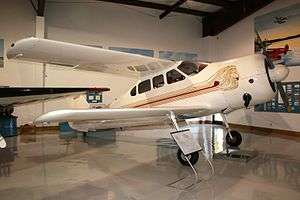Griffon Lionheart
The Griffon Lionheart is an American single-engined, six-seat biplane designed and produced in kit form for home building by Griffon Aerospace of Harvest, Alabama.
| Lionheart | |
|---|---|
 | |
| A Lionheart in an aviation museum in Tennessee, USA | |
| Role | Six-seat homebuilt kit biplane |
| National origin | United States |
| Manufacturer | Griffon Aerospace |
| First flight | 27 July 1997 |
Design and development
The Lionheart is based on the Beechcraft Staggerwing biplane of the 1930s;[1] but unlike the steel tube, wood and fabric construction of the Staggerwing it has a composite structure.[2] The Staggerwing has strut-braced wings but the Lionheart has cantilever wings with a total area about 20% less than the wings of the Staggerwing.[1] It is powered by a 450 hp (336 kW) Pratt & Whitney R-985 Wasp Junior radial engine with a three-bladed propeller. It has a retractable conventional landing gear with a tailwheel.[2] The enclosed cabin is slightly longer than the Staggerwing's cabin to allow room for the pilot and five passengers, and it has a split airstair access door on the port side.[2][3]
The Lionheart first flew on 27 July 1997 and was first displayed in public at EAA AirVenture Oshkosh a few days later.[1][4] Five kits were sold by April 1998, and two of the kits were completed by 2001, with another almost complete.[1][2][3] As of August 2011, three Lionhearts are registered in the United States, with another example on display in an aviation museum at Tullahoma Regional Airport in Tullahoma, Tennessee.[5][6] Kits are no longer being produced.[1]
Specifications
Data from [2]Jane's All the World's Aircraft 1999-2000
General characteristics
- Crew: 1
- Capacity: 6 (including pilot)
- Length: 26 ft 9.5 in (8.17 m)
- Wingspan: 31 ft 0 in (9.45 m)
- Height: 8 ft 0 in (2.44 m)
- Wing area: 118 sq ft (10.96 m2)
- Empty weight: 3,140 lb (1,424 kg)
- Gross weight: 5,200 lb (2,538 kg)
- Powerplant: 1 × Pratt & Whitney R-985 Wasp Junior radial piston engine , 450 hp (336 kW)
Performance
- Maximum speed: 230 mph (370 km/h, 200 kn)
- Cruise speed: 210 mph (338 km/h, 180 kn)
- Stall speed: 56 mph (91 km/h, 49 kn)
- Range: 1,956 mi (3,148 km, 1,700 nmi)
- Service ceiling: 20,000 ft (6,095 m)
- Rate of climb: 2,500 ft/min (13 m/s)
References
Notes
- "Lionheart History" (PDF). Griffon Aerospace. Archived from the original (PDF) on 20 March 2012. Retrieved 4 August 2011.
- Jackson 1999, pp. 649-650
- Davisson, Bud. "Space Age Anachronism: Griffon Aerospace Lionheart". Retrieved 4 August 2011.
- "News in Brief: Lionheart Entrance". flightglobal.com. Flight International: 22. 13–19 August 1997. Retrieved 4 August 2011.
- Serial number search of the Landings.com US civil register database, using "GA-LH-" as the serial number search parameter and "Lion Heart" as the Model parameter. Search conducted 4 August 2011.
- "Cianchette Lionheart". Beechcraft Heritage Museum. 2010. Retrieved 4 August 2011.
Bibliography
- Paul Jackson, ed. (1999). Jane's All the World's Aircraft 1999-2000. Jane's Information Group Limited. ISBN 0-7106-1898-0.
External links
| Wikimedia Commons has media related to Griffon Lionheart. |